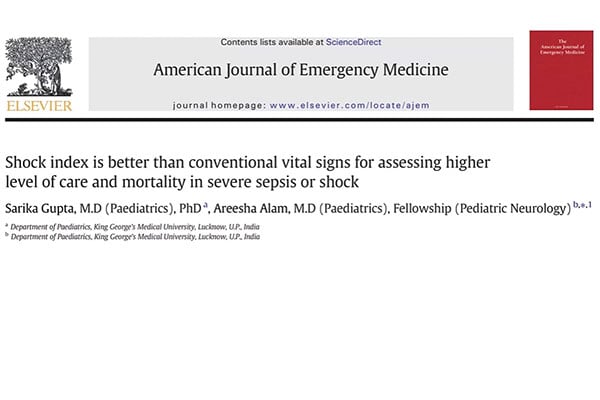POCUS for the WIN


Publish how point of care ultrasound guided management in your case!
Thank you for your interest in authoring an article for POCUS FTW, a case report series within the EM Resident magazine. Our goal with POCUS FTW is to highlight cases in which the use of point of care ultrasound led to a change or advancement in the diagnosis or treatment of a patient that otherwise would not have occurred without the use of this modality.
Submission Guidelines
Thank you for your interest in authoring an article for POCUS FTW, a case report series within the EM Resident magazine. Our goal with POCUS FTW is to highlight cases in which the use of point of care ultrasound led to a change or advancement in the diagnosis or treatment of a patient that otherwise would not have occurred without the use of this modality. Please adhere to the following submission guidelines in order to facilitate prompt peer review and layout for electronic and printed publication.
Submit articles to EMRApocusFTW@gmail.comPOCUS FTW Case Report Formatting
To standardize our submissions, please follow these guidelines. Each section should be a short standalone paragraph. Not every section requires a header (see below for specifics).
Sections:
- History of Present Illness:
○ Include a brief summary of salient historical topics in paragraph form.
○ Include a brief review of pertinent positives and negatives of the review of systems.
○ Include a brief mention of relevant past medical/surgical/social/family history.
○ Use present tense (e.g. “patient presents with”, “reports pain”, “describes blurry vision”, etc.) - Physical Exam:
○ Include vitals (temp, HR, BP, RR, SpO2).
○ Include pertinent positive exam findings in paragraph format.
○ Use present tense (e.g. “examination reveals”, “patient demonstrates”, etc.) - Labs and imaging:
○ Include pertinent labs and imaging in paragraph form.
○ Include standard reference ranges for uncommon tests.
○ Do not include the POCUS findings in this section. - POCUS
○ Include the type of POCUS study performed and include the probe, preset, and positioning used to obtain the view.
○ Highlight relevant findings within the images provided.
○ Include placeholders and captions for the images you intend to use. Video clips can be included with a QR code linking to a video/gif hosted on a separate platform.
■ Make sure the images are de-identified of patient information. - Discussion
○ Should be a separate section with a header
○ Most commonly an evidence-based review of the disease and the use of POCUS in diagnosis or management of this condition.
○ Include basic epidemiology of condition (incidence/prevalence)
○ Include common presentations of this condition
○ Include the sensitivity and specificity of POCUS for this condition, as well as the comparison of sensitivity and specificity of other diagnostic modalities available for this condition (X-ray, CT, physical exam).
○ Include a discussion of the limitations or barriers associated with POCUS in diagnosing or treating this condition
○ Include brief discussion of the management of this condition - Hospital Course/Resolution
○ Include a discussion of the patient’s subsequent hospital course and outcome
○ Include results of subsequent tests or imaging obtained in the hospital
○ Use past tense (e.g. “patient was admitted”, “cultures grew”, “patient was discharged”, etc.)
○ Section may highlight outpatient follow up if the patient was discharged - References
○ In-text reference numbers should be placed after the period as a superscript, like this.1
■ Arabic numerals (i.e. 1, 2, 3) are used
■ Not roman numerals (i.e. i, ii, iii)
○ Listed in the order in which they first appear in text (not alphabetically)
○ Should follow the American Medical Association Citation Style Guide
■ Except: remove DOI
○ For example:
- Schmitz GR, Clark M, Heron S, et al. Strategies for coping with stress in emergency medicine: Early education is vital. J Emerg Trauma Shock. 2012;5(1):64-69.
EM Resident Submission Guidelines
- GIVE PROPER CREDIT. Include the name, credentials, title, institution, and social media tags of ALL authors at the top of your Word document.
- Please include a portrait of each author
- Do not plagiarize. Use citations, and format your references per AMA Style.
- Do not submit your article simultaneously to any other journal.
- Articles must be at least 700 words, not including references. There is no upper word limit; be thorough but concise.
Photos/Charts/Graphs/Scans
- Send your images as separate jpg, png, tiff, or gif files – not embedded in your Word document.
- If you use a copyrighted photo, scan, chart, or graph, then written permission must accompany it. No exceptions. (Email counts as written permission. And FYI: Every journal is copyrighted, as are most blogs.)
- If you grab an image off the Internet, written permission must accompany it.
EMRA Style Guide for EM Resident
EM Resident follows the AMA Manual of Style and the Annals of Emergency Medicine style in most cases, although some exceptions apply:
- EMRA: No need to spell out Emergency Medicine Residents’ Association on first reference.
- Abbreviations: Include abbreviations in parentheses upon first reference. (Example: The Accreditation Council for Graduate Medical Education (ACGME) offers a workshop on leadership skills for chief residents.)
- Serial comma (aka Oxford comma): Use it. (Examples: “one, two, and three” but never “one, and two”)
- Emergency medicine: Do not capitalize unless it’s part of a proper noun, and it's OK to use EM on second reference. (Example: The specialty of emergency medicine was approved by the American Board of Medical Specialties (ABMS) in 1979.) • Emergency department: Do not capitalize unless it’s part of a proper noun, and it's OK to use ED on first reference. (Example: ED visits are on the rise.)
- ER: If it’s part of a proper name, it’s OK to keep. Otherwise the term is emergency department (not capitalized) or ED.
- Headlines and subheadings: Include them on your paper, please. A descriptive, engaging headline sets expectations for the reader, and subheadings are important to help readers scan quickly.
- Take-home points, pearls, and calls to action: All of these help readers connect with
your article. Include them when it makes sense to do so.
Related Content



Feb 25, 2021
Trailblazers in Emergency Medicine : CCM
The EMRA Critical Care and D&I Committees hosted a fireside chat discussing the integral role of women and URiM in EM-CC. This discussion will launch an initiative designed to increase representation and mentorship for URiM and women in emergency medicine critical care fields.




